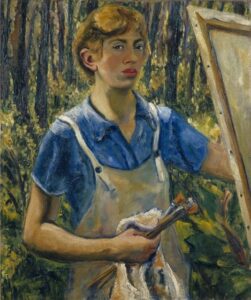 “At seventy-five, Krasner is finally getting her due.” These words were written by art critic Robert Hughes in his 1990 Times article about Krasner’s first retrospective at the Houston Museum of Fine Arts. Krasner had been a practising artist since the 1930s, so why weren’t more art institutions jumping at the opportunity to display the work of a pioneering American abstract painter? Female artists struggle to get the credit and representation they deserve. To help amend past actions and attempt to heal deep wounds, the Barbican’s ‘Lee Krasner: Living Colour’ places Krasner centre stage with one of the largest ever retrospective showings of her work. The exhibition includes photography, mosaics, oil on canvas, collages, mixed media, and a fantastic short film about Krasner at the end of the show. Whether you are well versed in Krasner’s ability, or have never heard of her before, this exhibition provides an in-depth look at her as an artist, woman, and human.
“At seventy-five, Krasner is finally getting her due.” These words were written by art critic Robert Hughes in his 1990 Times article about Krasner’s first retrospective at the Houston Museum of Fine Arts. Krasner had been a practising artist since the 1930s, so why weren’t more art institutions jumping at the opportunity to display the work of a pioneering American abstract painter? Female artists struggle to get the credit and representation they deserve. To help amend past actions and attempt to heal deep wounds, the Barbican’s ‘Lee Krasner: Living Colour’ places Krasner centre stage with one of the largest ever retrospective showings of her work. The exhibition includes photography, mosaics, oil on canvas, collages, mixed media, and a fantastic short film about Krasner at the end of the show. Whether you are well versed in Krasner’s ability, or have never heard of her before, this exhibition provides an in-depth look at her as an artist, woman, and human.
The exhibition begins by highlighting specific periods of Krasner’s career rather than taking a linear approach. The first vignette, albeit a puzzling choice, is Krasner’s Little Images from the 1940s. Little Images, a collection of mosaics, was an important junction in Krasner’s career, but you don’t fully grasp that until later in the show. The curatorial team relies heavily on printed literature and posted information to guide the viewer, which is not always going to be utilized effectively. As you progress further into the show, more information about Krasner’s early career is presented and you become aware she had prestigious artistic training, even attending a school led by Hans Hoffman. Unfortunately, Hoffman’s reception of Krasner’s work adhered to a common perception of the time that female artists were not as good as their male counterparts, saying of her profound skill as an artist that her work was “so good you wouldn’t know it was done by a woman.” After her schooling Krasner was employed as the head of an artistic team under the Public Works of Art Project 1933 (part of Roosevelt’s New Deal). From there she would pioneer her own path as an artist. A prominently featured section is the space given to Prophecy, Birth Three in Two, and Embrace, three of Krasner’s most prominent works. These act as haunting reminders of Krasner’s need for reinvention, adaptation, and change.
To Krasner, Matisse and Picasso were the artists to revere, “Gods” of the art world (an unfortunate, yet understandable belief, given Picasso’s own opinions on female artists). This reverence is apparent in her work as you progress through the rest of the exhibition, which is grouped by decades as her style changed. As you walk among Krasner’s pieces, you begin to compile a long list of genres she learned from, including cubism, formalism, abstraction, and of course abstract expressionism. From her first solo exhibition in 1951 to taking over Pollock’s studio in the barn at Springs in 1957, showing at Whitechapel in 1956, the exhibition at the Whitney Museum of American Art in 1973, and now the Barbican’s exhibition, a fitting word to describe Krasner as an artist is ‘adaptive’. She was an artist who was willing, if not consumed by, the desire to recharge, rework, and even destroy her own work for the sake of continuity in her career. She constantly went back to her past work, rebuilt it, repurposed it to create a new
practice and progress. A leading figure in her field, art history has perhaps not given her enough credit. Krasner was a vocal vanguard for American Artists. There is a ‘now’ factor to Krasner’s work; she is an artist who should be looked to by creators today who are struggling with what it means to be an artist. Rebirth, change, growth: all ideas that Krasner exemplified and displayed in her practice. These concepts have not run the course of their usefulness, and artists today should follow in Krasner’s footsteps to repurpose them for their own generation.
Alexander Stanfield
The Adaptive Artist – Lee Krasner, 30 May – 1 September 2019, Barbican Art Gallery, London
Volume 34 no.2 November/December 2019 p 31
